
"Hearst Magazines and Yahoo may earn commission or revenue on some items through these links."
If you've ever tried installing a car seat with one hand while wrangling a toddler and balancing a hot Americano, you already know the struggle: Not all car seats are created equal. Some are intuitive and rock-solid, with easy-to-use designs. Others feel like you've been sent to installation purgatory.
To help you find the right car seat for you, we dug into the latest and greatest convertible car seats on the market to ensure your child stays safe and you stay sane. Convertible car seats are meant to be used for years, so we tested everything from design and materials to installation and cleanability, so you're as prepared as possible when it comes time to purchase the one that will serve your child from toddlerhood to kid-dom.
More Gear Tests: Best Infant Car Seats | Best Booster Car Seats | Best Car Phone Mounts
Key Takeaways:
With clean lines, leather accents, and multiple color options, the Uppababy ROVE is our Best Overall pick because it's designed for parents who value aesthetics as much as function; it's not great for small cars, though.
If you drive a compact or sports car—or your family runs three-wide in the back seat—the Britax One4Life Slim is Best for Small Cars.
Our Best Value pick is the Chicco NextFit Zip—what a convertible seat should be at its price point.
Things to Consider When Buying a Convertible Car Seat
Cleanability
There's no escaping messes. It doesn't matter how hard you try—there will be spills, there will be blowouts, and there will be crumbs. While all the seats we tested cleaned up relatively well after spills, we (unsurprisingly) found lighter-colored fabrics are more prone to visible staining, so we recommend sticking to darker or more pattern-heavy fabrics.
It's also worth noting that the real challenge lies in removing the seat cover for cleaning. Some car-seat designs make this process quick and intuitive, while others require a wrestling match with straps, snaps, and headrests. If deep cleaning is a priority, look for models with easier fabric removal.
Ease of Installation
Some seats practically click themselves into place. Others make you question your life choices. Be sure the attachment system is easy to use and works well with the various anchor points in your vehicle, such as the standardized Lower Anchors and Tethers for Children (LATCH) system. This can be difficult to judge from product photos, so look through our reviews, other consumers' reviews, and even head to your local Target or Costco and check out some display models to see how they operate.
Size and Fit
Not every seat fits every car, and that can be a rude surprise if you drive something with a tight back row. The big, cushy models might look great, but if they eat up half of your back-seat area, they may present a host of other problems you'll need to deal with. Always check dimensions, and if you're trying to fit three across, pay extra attention to car-seat width.
Adjustability
A convertible car seat is a long-haul investment, so you want a seat that grows with your kid. Look for easy-to-move headrests and harnesses you don't have to rethread by hand every few months. The more adjustability you have, the longer you can stretch the seat's usefulness and avoid shelling out for another one (so long as the seat isn't expired, of course).
Comfort and Materials
Good padding, breathable fabric, and decent head support can go a long way in keeping the peace on long road trips. For bonus points, buy a seat where the cover is easily removable and machine-washable. I speak from experience when I tell you the first spilled-milk incident (or unexpected blowout) will arrive sooner than you think.
Weight and Portability
If you're moving the seat between cars often (or lugging it through an airport), pay attention to how heavy it is. Some convertible seats are built like tanks, which is great for everyday use but brutal for portability and travel. Lighter doesn't always mean flimsier, and a lighter seat will be easier on your back.
Recline and Slide Options
You'll want a seat that plays nice with your car's back-seat geometry. Having more varied recline angles and adjustments can help with that, especially if your vehicle has deep seat cushions or tricky slope angles. Most car seats will come with included level bubbles or other means of ensuring it's at the right position for your child's height and weight. If it doesn't, make sure you know how to position the seat for optimal safety.
Price vs. Practicality
While convertibles are usually pricier than age-specific child car seats, you don't need to max out your credit card to get a safe, solid one. Some budget-friendly models nail the essentials without loading on bells and whistles you'll never use, while some expensive options might prioritize innovative style and design over basic comfort and practicality. What's important to you? Consider the overall value and feature set based on your vehicle and needs.
Best Convertible Car Seats, Tested
Rove
Designed for parents who care about aesthetics just as much as function, the Uppababy Rove features clean lines, leather accents, and color options that generally match modern vehicle interiors. Installation is straightforward but not particularly fast. Still, the tension bar provides clear green/red feedback to indicate proper tightness, which is a helpful feature for parents.
Usability is good. While not deal breakers, the recline adjustment is accessed from the back of the seat, and the headrest must be lifted to adjust the tension bar underneath, making on-the-fly changes difficult. The five-point-harness system is intuitive, and the contours of the seat make it easy to load a child in and out. The seat sits fairly high in the vehicle, so if you're working with a short vehicle or compact car, you might struggle to get larger children in and out of the seat comfortably, especially once they reach the upper end of the weight and height limits.
The Rove's cushioning feels more on the firmer side compared to other units we tested, and as a whole, the seat feels like it'll hold up for years to come. At 25.7 pounds, the weight is average, and the base includes a grippy underside that's especially effective on leather seats. Buckle storage and a solid cupholder round out the features.
Cleanup is fairly straightforward thanks to a removable top layer, though the bottom corners and seatbelt area still trap crumbs. The neoprene-like fabric wipes down easily. Cover removal is quick and simple, with Velcro and tabs making the process smoother than expected.
As a whole, the Rove is a well-styled, moderately comfortable seat that works well in larger vehicles. It's less ideal in compact cars due to height and rear-facing bulk, but its premium look and feel do make it a compelling option.
Below is a gallery of the Uppababy Rove in front- and rear-facing positions in each of the cars we tested:
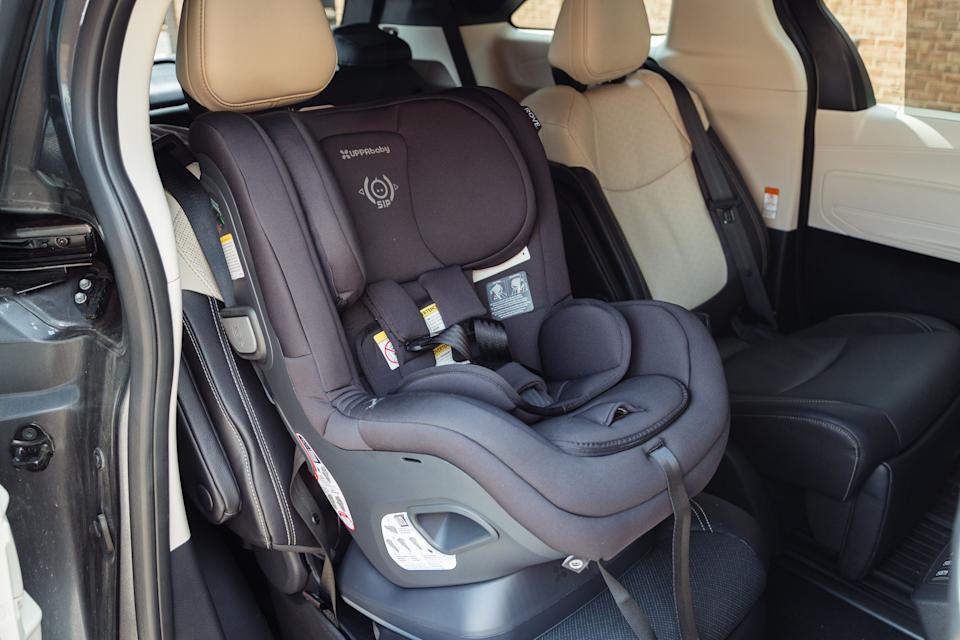
Fit360 ClearTex
Chicco's Fit360 Zip ClearTex features an impressively smooth rotating base that eliminates the need to uninstall the seat to switch between rear- and forward-facing modes. That convenient rotation feature works exceptionally well, provided your vehicle has the space. In SUVs such as the Honda CR-V or minivans like the Toyota Sienna, it makes child loading and unloading faster and far easier than static units; just spin your child till they're facing you, and pull them straight out. In tighter vehicles, however, the rotation can get obstructed by front-row seatbacks, rendering the function effectively unusable unless you're willing to slide the seat forward and backward each time.
Installation is fairly intuitive; the Fit360 uses carabiner-style LATCH anchors that feel secure and are easy to tighten. A single pull strap tightens everything in place, and the recline is adjusted by a level arm under the base. Like most rotating seats, though, it's heavy. At 33.7 pounds, this is one of the bulkiest in our test, so you won't want to move it frequently between cars.
Build quality is a mix. The leather side panels are a nice touch, but the main seat cushion is on the firmer side and lacks the plush feel of a few of the other seats we tested. Cleaning is straightforward thanks to the zip-off cover, and the magnetic clasp system on the chest buckle is a welcome upgrade.
The shape of the Fit360 means there are quite a few crevices where smaller debris can get stuck and be difficult to vacuum, but for solid and liquid messes alike, the zip-off construction makes it easy enough to access the hard-to-reach areas and throw the worst of it in the washer.
The Fit360 is a smart, practical choice for families with larger vehicles who value the convenience of a rotating seat. It delivers on its design promise when space allows, but it feels compromised in anything smaller than a crossover.
Below is a gallery of the Chicco Fit360 ClearTex in front- and rear-facing positions in each of the cars we tested:
Chicco Fit360 ClearTex Image Gallery
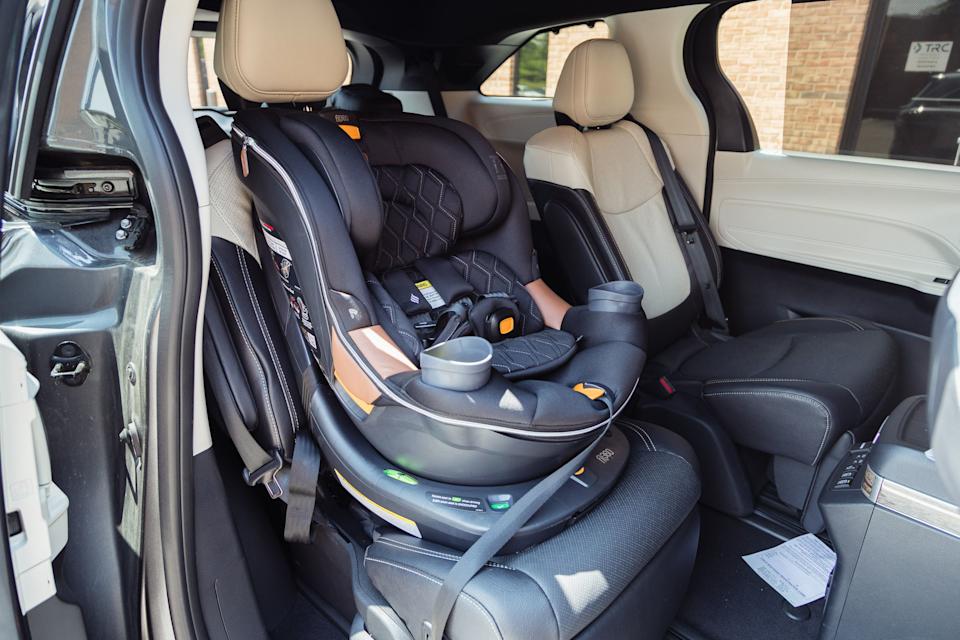
Revv
The Nuna Revv strives to bring luxury and ease-of-use into the rotating-seat category. And it largely succeeds, so long as you have the right vehicle. The Revv features a true 360-degree swivel, making it easy to load a child in either orientation. But, as we've seen with other rotating car seats, space matters. In small sedans, the seat presses firmly against the front seatback in rear-facing mode, limiting its rotation; in certain cars, achieving the correct recline angle could be a concern. Installation is done via LATCH or vehicle belt, and while setup is generally intuitive, finding the "true tension door" can take more trial and error than it should, even for experienced parents.
Once secured, though, the Revv sat firmly in the center of essentially every back seat we put it into thanks to its wide base. The tension strap at the rear tightens cleanly and releases just as easily, making installation feel precise and secure. Rotating the seat requires pressing a lever mechanism underneath the side bolster.
Build quality is fantastic across the board. The leather-wrapped base handle feels upscale, and the seat's outer shell is solid. The infant insert is well-cushioned and well-contoured, though the main padding elsewhere on the seat is average. The headrest moves smoothly and locks with a satisfying click, and small features such as the twin rubber-bottomed cupholders add to the premium feel. At just over 30 pounds, the Revv is on the heavy side, but the build quality—with its heavier, more robust materials—is what accounts for most of that weight.
This seat does a solid job keeping most smaller debris accessible with a vacuum cleaner, with only a few side gaps allowing crumbs in. The neoprene-like material is easy to wipe, and once you learn the order of operations, cover removal is straightforward for more in-depth cleaning.
The Revv is a premium option for families driving larger vehicles. Its rotation and material choices justify its price for those who prioritize build and aesthetics. But if you drive a smaller car, rear-facing fitment is too tight for us to recommend it confidently, and the seat's bulk outweighs its benefits in those scenarios.
Below is a gallery of the Nuna Revv in front- and rear-facing positions in each of the cars we tested:
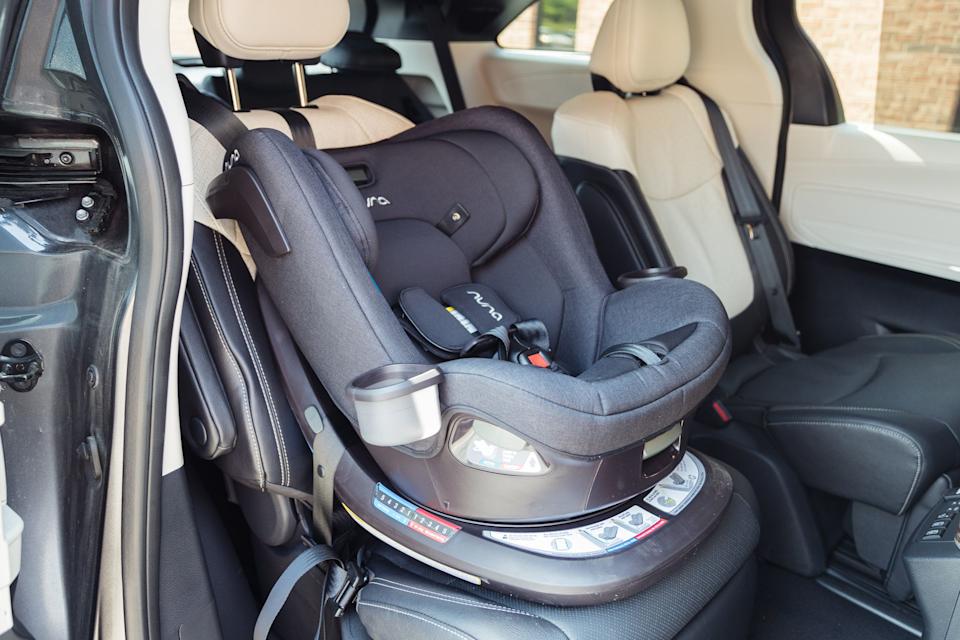
NextFit Zip
The Chicco NextFit Zip is arguably the most user-friendly convertible seat in this test. Installation is straightforward thanks to Chicco's SuperCinch system, which uses a force-multiplying mechanism to lock the seat down tightly with just a single hand, rather than the significant effort other seats can require. Color-coded belt paths and clearly labeled straps eliminate confusion during setup, and the seat stays securely in place once installed. In smaller vehicles like a Honda Civic, the NextFit is a bit tight rear-facing but remains solid and usable.
Installation and daily usage impressed us once we got the hang of things. The headrest raises easily, and the recline adjustment is simple and accessible. The harness tightens with the pull of a strap, loosens with the press of a button, and the shoulder straps feel secure without needing constant retightening. The buckle design is straightforward, not requiring excessive force, and while we did encounter an issue with the LATCH strap getting caught in the SuperCinch housing, this shouldn't be an issue for most; just make sure the strap isn't twisted as you're tightening it down.
Materials and build quality are excellent. The seat features leather-wrapped accents that add both style and function, protecting nearby trim during loading. The seat padding is dense and comfortable without being too soft, and the fabric cover unzips fully for easier cleaning. At 25.8 pounds, it's not exactly a lightweight, but the quality and ease of use more than justify the extra mass.
One area where Chicco's Zip series shines is in its ability to quickly shed just a single layer for cleaning up messes. While crumbs from Cheerios did get trapped in the side bolsters, liquid messes cleaned up well with a wipe, and removal of the top fabric was extremely simple thanks to the zippered construction.
The NextFit Zip is a benchmark for what a convertible seat should be at its price point. It's comfortable, thoughtfully designed for children and parents alike, and extremely easy to install and use. If you're looking for a no-compromise seat that works in a wide variety of vehicles, this is it.
(One final thing we learned during this test: Chicco is pronounced "kee-ko." Now you know.)
Below is a gallery of the Chicco NextFit Zip in front- and rear-facing positions in each of the cars we tested:
Chicco NextFit Zip Image Gallery
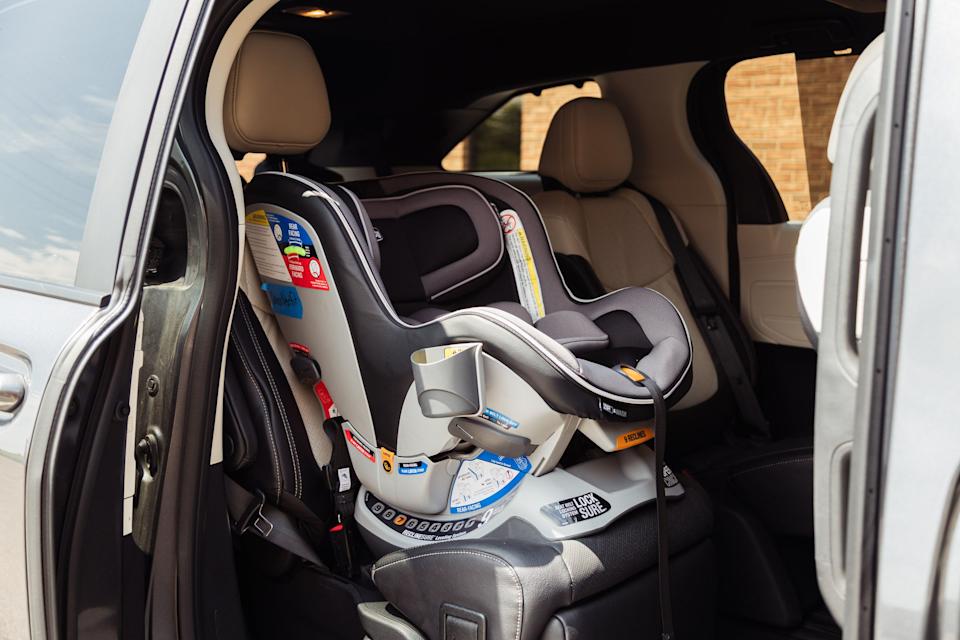
One4Life Slim
We love it when a product lives up to its name. The Britax One4Life Slim is the most space-efficient convertible seat we tested, making it a great option for smaller vehicles or families running three-wide. Installation via Britax's QuickTight system is relatively smooth once you understand the sequence. It's also one of the few seats where a belt install feels just as good as using the LATCH setup.
Once installed, the seat doesn't budge. Reclining is simple and smooth, the top tether is easy to reach, and the harness adjuster under the seat is intuitive—an area where several other seats are lacking. The buckle design is especially good: solid, secure, and easy to use. There's no rotation or fancy tech here, but every function is clear and dependable. The shoulder-strap mechanism adjusts without fuss, and the seat locks firmly in both orientations across the vehicles we tested.
Where the One4Life falls a little short is comfort. The padding is firmer than it looks, and despite the seat's solid construction, it lacks the plush feel of its Chicco or Evenflo counterparts. That said, the lack of extra padding is what helps make it one of the thinner seats of the bunch, so it's the necessary sacrifice for making it so compact. Also, installing the cupholders requires a flathead screwdriver—an annoying outlier in a market where tool-less assembly is more or less standard.
The back of the seat is sealed off well, helping contain messes, though the sides still collect crumbs. The neoprene-like fabric wipes clean easily, and the cover removes quickly thanks to a straightforward snap-and-band system.
The One4Life Slim is a standout for its compact footprint and secure installation in a variety of vehicles. It's an excellent choice for families with smaller vehicles or multiple car seats to juggle. If you want a seat that works seamlessly in tight spaces or plan to go three-wide in the back seat, this is the car seat for you.
Below is a gallery of the Britax One4Life Slim in front- and rear-facing positions in each of the cars we tested:
Britax One4Life Slim Image Gallery
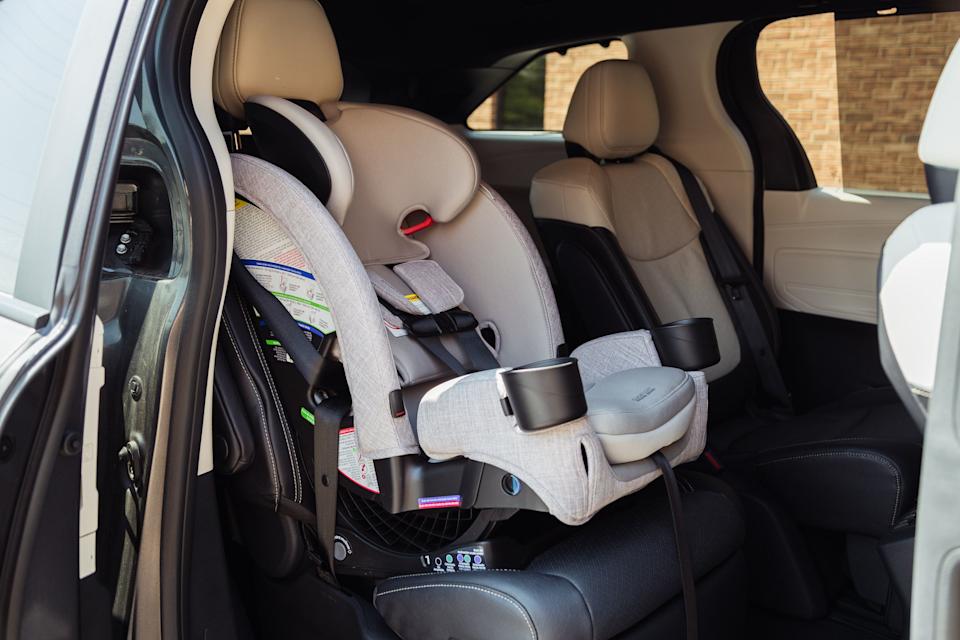
Scenera Next
The Cosco Scenera Next is about as no-frills as a convertible car seat gets, and that simplicity—resulting in a remarkably affordable price tag—is exactly its appeal. At just over seven pounds, it's far lighter than anything else we tested. This makes it an ideal option for travel, secondary vehicles, or ride-share situations. Installation is incredibly simple: The seat uses a straightforward belt-routing system in both front- and rear-facing orientations. And while it lacks mechanical tensioners, it's easy to get a reasonably tight fit using a vehicle's seat-belt locks.
The harness system adjusts manually, and there's no built-in mechanism for quick tightening or loosening. The shoulder straps must be moved manually as your child grows, and the belt path isn't reinforced with padding—something to keep in mind for comfort. There's a metal tab under the seat to release the shoulder harness, but it feels outdated compared to other models with more comfortable, contoured release buttons. Still, the simplicity means fewer parts to fail or misalign.
Materials are minimal. The seat is a thin molded plastic shell with a lightweight, removable fabric cover. There's little in the way of cushioning, and the included cupholder is flimsy at best. Long story short: Don't expect plush comfort or extra features.
Crumbs fall through to the vehicle seat below, which can be helpful or annoying depending on your car. The loose fabric doesn't respond well to upholstery cleaner, but removing the cover is simple—just unhook the straps and lift it off like a fitted sheet.
The Scenera Next doesn't excel in comfort or quality, but as a lightweight, affordable, and easy-to-use backup seat, it does exactly what it's supposed to. Just know its limits: This is safety compliance at its most minimal.
Below is a gallery of the Cosco Scenera Next in front- and rear-facing positions in each of the cars we tested:
Cosco Scenera Next Image Gallery
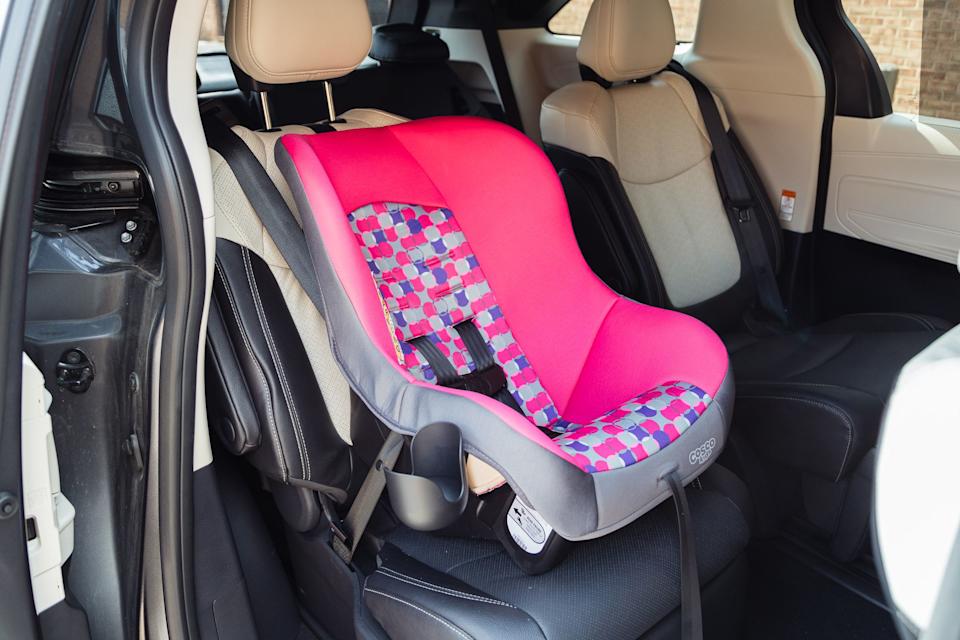
Gold Revolve360
The Evenflo Revolve360 brings a lot of features to the table, starting with its fully rotating base. In rear-facing mode especially, the swivel function makes loading and unloading a child far easier than with other car seats, particularly in taller SUVs or minivans. However, the rotation doesn't always function cleanly, as we unfortunately found out on multiple installs. It requires the seat to be at a specific recline angle, and if you miss that, it can be difficult to twist.
Installation is a mixed bag. The base-first approach is unique and helps with repeatable installs if you're moving the seat between vehicles. Anchoring is relatively easy with connectors that require a simple push to latch, but achieving a truly tight fit requires a bit more muscle than we'd like. Removing the seat from the base once installed takes a fair amount of strength, and aligning the seat properly for rotation can be tricky until you've done it a few times.
Overall comfort is where the Revolve360 shines. The infant cushion is one of the best in the group. It's soft, supportive, and clearly designed with newborns in mind. The standard seat padding is also quite good, and the included zip-off leg rest adds additional support in forward-facing mode. Evenflo includes thoughtful features like built-in buckle storage and a SensorSafe clip that alerts if a child is left in the seat. At 31.5 pounds, though, it's not something you'll want to carry around or travel with.
Mess cleanup is less efficient with the Revolve360 due to its deep crevices. Liquids wipe off decently, but the fabric removal process is slow and not very intuitive, requiring trial and error.
This is a feature-rich seat that's ideal for families with larger vehicles who want tech-forward convenience. But the inconsistent rotation and complexity of installation limit its appeal in smaller cabins or for users who want simplicity over gadgets.
Below is a gallery of the Evenflo Gold Revolve360 in front- and rear-facing positions in each of the cars we tested:
Evenflo Gold Revolve360 Image Gallery
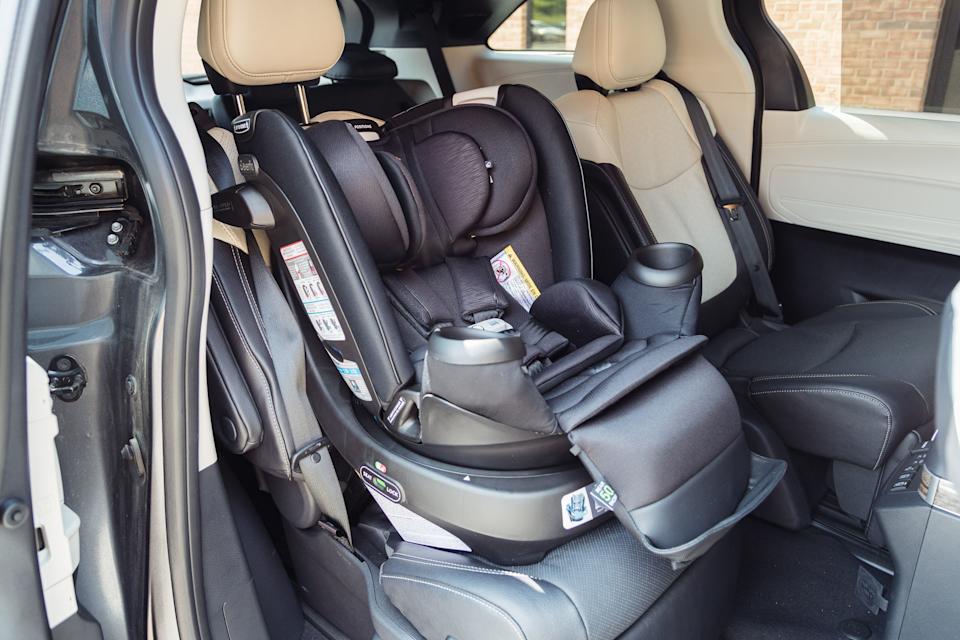
City Turn
The Baby Jogger City Turn markets itself as a space-saving swivel seat, but its rear-facing-only rotation comes with limitations. Specifically, the pivot point for the rotating mechanism is near the rear of the base, so when rotating in tighter back seats, the back shell frequently hits the front seat and makes it difficult to get a child in and out of the seat compared with other rotating bases. In testing, this made the swivel function mostly unusable in compact vehicles such as the Honda Civic and the Ford Maverick. It also doesn't rotate much in forward-facing mode due to its pivot point, reducing its utility as your child grows.
Installation was reasonably easy thanks to color-coordinating routing paths, but having to lift up the padding of the seat to ensure proper routing for belts or LATCH mechanisms was less than ideal. We did, however, appreciate the simplicity of the flipping adjuster used to turn the seat from front to rear facing.
The seat lacks a carry handle and weighs 28.2 pounds, making it difficult to maneuver. Adjusting the headrest is easy, but there's no built-in recline, so the seating position is fixed based on the vehicle's seat and the flipping "wedge" underneath that adds height to either the front or back, depending on whether the seat is front or rear facing.
Comfort is a major plus of this car seat. The City Turn uses thick memory foam, one of the softest cushions in this comparison. The materials feel genuinely high-end, and the harness includes grippy textures to help keep your child in place. Buckle storage pockets are included so you're not putting your kid on top of the buckles every time you load them up, and the seat design cradles the child nicely. There's only one cupholder, but it feels sturdy and well placed.
As for cleaning, crumbs and debris tend to get deeply lodged, especially around the harness slots, and the memory foam retains some moisture with liquid messes. On the plus side, the cover removes in just two main pieces, making disassembly fairly quick.
This is a very comfortable seat that could work well in larger vehicles. However, its limited swivel range, cumbersome install process, and fixed seat geometry make it hard to recommend for users who need flexibility or who drive compact cars.
Below is a gallery of the Baby Jogger City Turn in front- and rear-facing positions in each of the cars we tested:
Baby Jogger City Turn Image Gallery
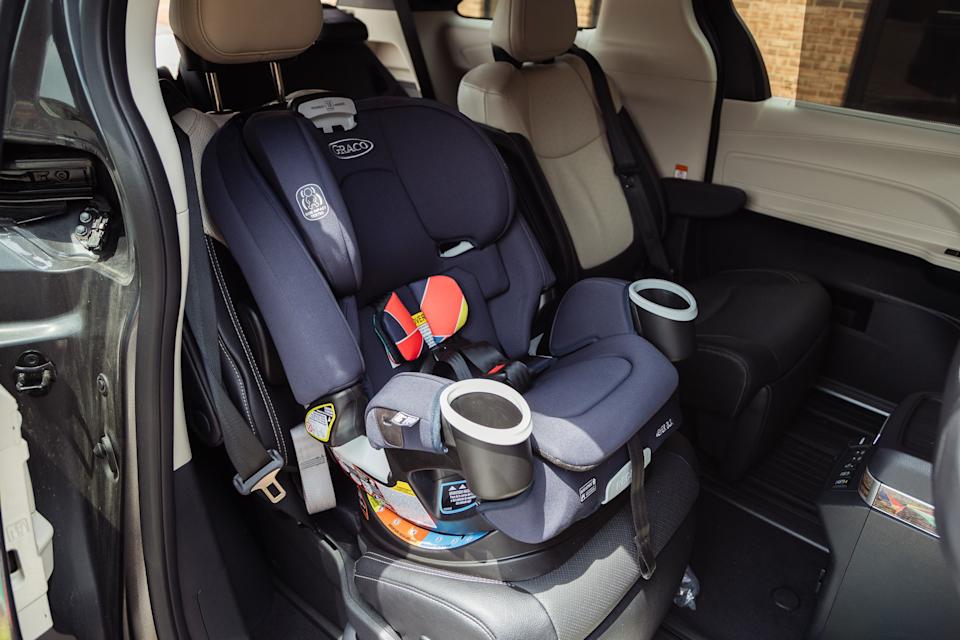
4Ever DLX 4-in-1
The Graco 4Ever DLX all but promises to be the only seat you'll ever need. Specifically, it covers rear-facing, forward-facing, high-back-booster, and backless-booster configurations. In theory, it's a budget-friendly long-hauler that should save you money when all is said and done. In practice, however, it's one of the more frustrating seats to install and use of those we tested. The LATCH anchors lack a cinch mechanism, so tightening them is an awkward process with inconsistent results. The seat relies on friction and force, not mechanical advantage, which isn't ideal when you're lacking leverage—especially in more compact vehicles.
Once installed, the DLX does have some functional wins. The headrest moves smoothly, the recline mechanism is intuitive, and the dual cupholders are well placed. But changing modes (from rear to forward facing, or to booster use) means disassembling and rerouting straps. The DLX's long shell also eats up a good bit of legroom for a nonrotating car seat. Without a rotating feature or easily accessible tether points, this seat requires both patience and ample cabin space.
Material quality is respectable—the cushioning used throughout is firm but comfortable. As for portability, it's a 21.7-pound seat without any carry handle. The plastic base looks clean enough but lacks the visual or tactile confidence of the better-built seats we tested. The buckle does feel solid, and the strap storage pockets are useful.
When it comes to messes, liquid spills wipe up relatively easily, and upholstery cleaner works well on the fabric, but dry debris like Cheerios tends to fall between the seat padding. Fabric removal takes some effort, but it's not overly difficult.
The 4Ever DLX makes sense if you're after a single purchase that follows your child through all car-seat stages. But in terms of everyday function, comfort, and installation, it's outclassed by seats that offer better mechanisms, softer materials, and smarter design.
Below is a gallery of the Graco 4Ever DLX in front- and rear-facing positions in each of the cars we tested:
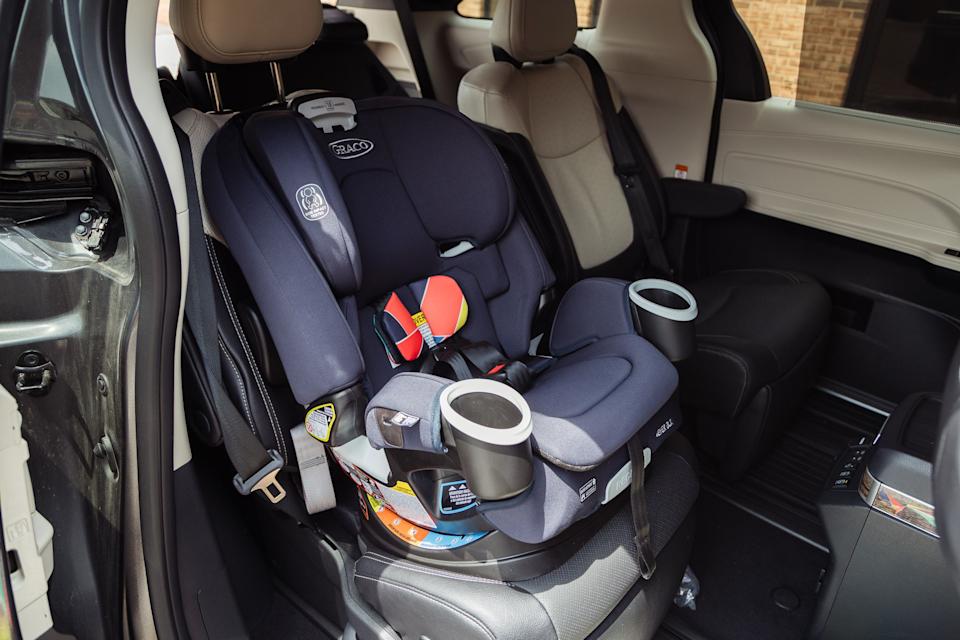
Extend2Fit
The Graco Extend2Fit shares a lot of DNA with the 4Ever DLX, including a nearly identical shell and anchor system. The main difference is its sliding legrest in rear-facing mode, which gives kids more legroom. It's a welcome addition for growing toddlers, but it doesn't solve the underlying issues. Installation is again labor-intensive—LATCH straps lack leverage, and the ball-style recline level is vague at best. Adjusting the straps or changing orientations means partially disassembling the seat.
Usability is frustrating. The recline handle is built into the base and becomes difficult to access once the seat is installed—particularly in rear-facing setups. There's no intuitive path for adjusting the shoulder harness; instead, a hidden metal piece under the seat controls the tightness, and reaching it requires contorting your wrist, especially in more compact vehicles. The cupholders are hard to snap back in after removal, and the top tether had a habit of rattling against the seat back during testing.
Comfort is marginally improved with the leg extender deployed, and it does make rear-facing more viable in compact vehicles compared with the DLX. However, the cushioning is thin, the inserts are rough, and the harness lacks the smooth feel of more premium models. The seat weighs 18.5 pounds; lighter than the DLX and most of the other options, but its size still makes it a bit cumbersome.
Cleanup is quick for spills thanks to the smooth fabric, but like the DLX, small debris can fall into hard-to-reach areas. Removing the cover is more involved, with elastic loops, strap unhooking, and headrest adjustments slowing the process.
Unless extended rear-facing legroom is your absolute priority, the Extend2Fit brings too many of the DLX's flaws without meaningful functional improvements. It's passable in larger vehicles but ultimately undermined by the same clunky strap systems and cheap materials.
Below is a gallery of the Graco Extend2Fit in front- and rear-facing positions in each of the cars we tested:
Graco Extend2Fit Image Gallery
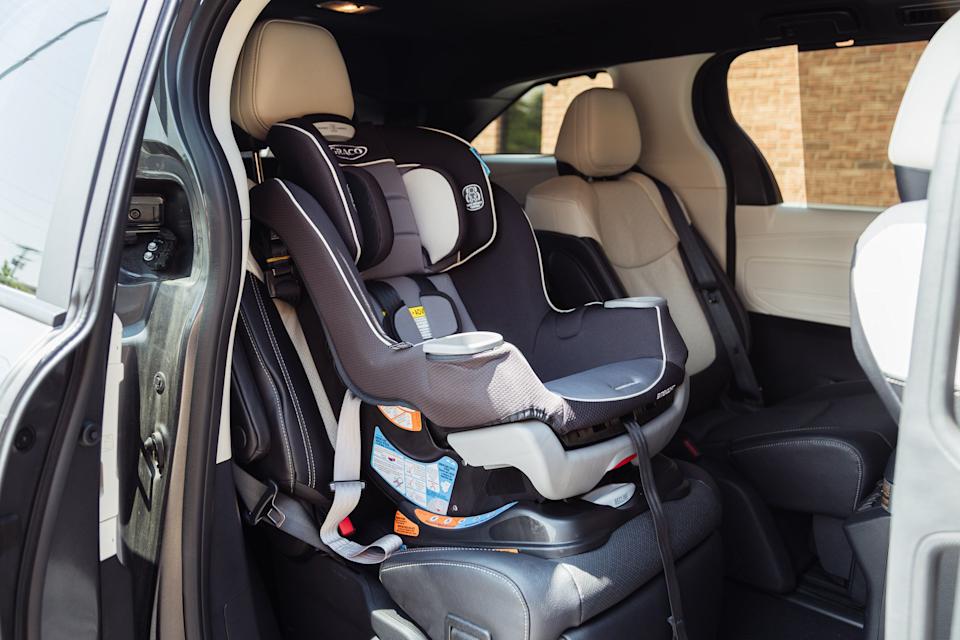
How We Tested Convertible Car Seats
Convertible car seats are meant to be a "buy once, cry once" solution to child restraints, but how they perform in the real world depends heavily on the vehicle they're installed in. To accurately reflect this reality, we tested each seat across a range of popular vehicles that represent the spectrum of American family transportation. Each seat was evaluated both objectively and subjectively, with safety compliance as a baseline and real-world practicality as the deciding factor.
Our vehicle test fleet includes some of the bestselling or most relevant models in their respective segments: a 2024 Ford Maverick (compact pickup), a 2025 Honda Civic Hatchback (compact sedan), a 2025 Honda CR-V (compact SUV), a 2025 BMW M2 (compact two-door coupe), and a 2025 Toyota Sienna (three-row minivan).
Each seat was installed in both rear- and forward-facing orientations wherever possible. We positioned the front passenger's seat for roughly the height of the average adult male. In each of the vehicles, our average adult male adjusted the seat to what he would consider a comfortable position, at which point we installed each of the seats.
We documented fitment issues, anchor-point accessibility, recline compatibility, legroom for both front and rear passengers, and how each vehicle's interior layout helped (or hindered) the process. The goal was to find out not just whether a seat can be installed, but whether it should be, and what compromises were necessary in tight spaces.
Installation was a key consideration. We evaluated each seat for clarity of instructions, intuitive belt routing, ease of accessing LATCH points, and whether a proper, tight fit could be achieved without excessive force. If a seat demanded disassembly, hidden levers, or multiple YouTube videos to complete an install, we made note of it.
Beyond installation, we looked at day-to-day usability: Is the harness easy to adjust? Can the seat be reclined or rotated without uninstalling it? Are the materials soft enough for long trips and sturdy enough for everyday messes? How heavy is the seat, and how much space does it take up when fully reclined? We removed covers, measured how well cupholders stayed in place, and noted any features that made our testers' lives easier or more difficult.
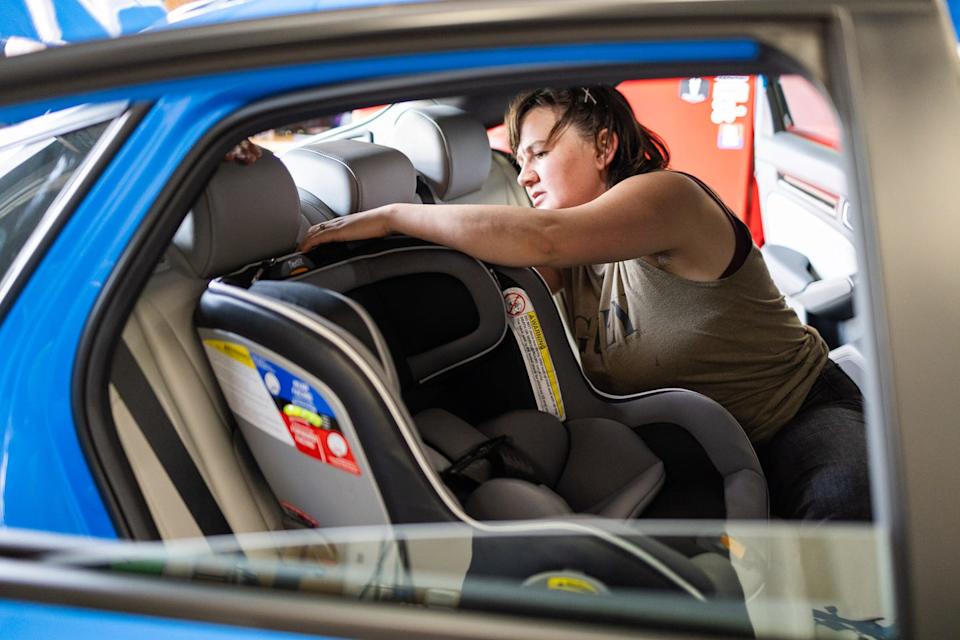
Seating Positions
These are the front-seat positions we chose for the Civic (top left), the CR-V (top right), the M2 (bottom left), and the Maverick (bottom left).
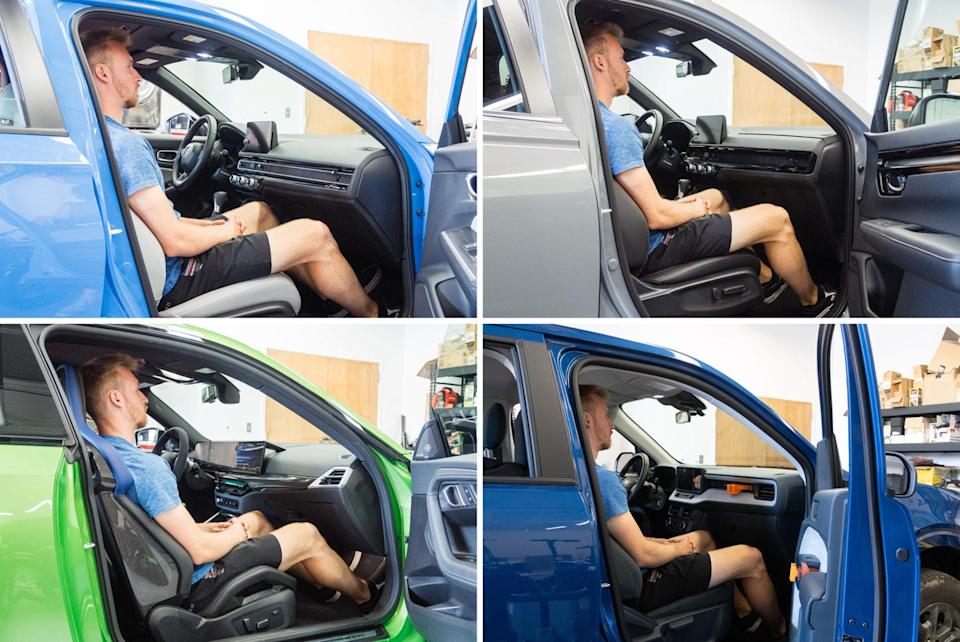
FAQs
When should I switch from rear facing to forward facing?
It's recommended to keep your child(ren) rear facing as long as possible. Specifically, as long as your kid fits within the seat's rear-facing height and weight limits (usually up to 40 or even 50 pounds), it's safest to keep them facing that way, as rear facing offers better protection in a crash.
Can I use a convertible seat from day one?
Generally speaking, yes. Some convertible car seats might not work for smaller infants, but most have a starting weight between five or six pounds when used with the proper newborn inserts. That said, they're not as portable as infant bucket seats, and they don't always offer the same snug fit for tiny babies. We've also heard of hospitals not allowing a newborn to be discharged if they feel the car seat isn't a secure fit—so keep that in mind when purchasing one if you're doing so ahead of your little one's arrival. If a convertible car seat won't work, you'll have to invest in an infant car seat as well.
Are pricier car seats actually safer?
Not necessarily. Every seat on the market has to meet the same basic safety standards (more on that below). What you're usually paying extra for are convenience features–like easier installation, nicer fabrics, or extended limits. A cheaper seat can be just as safe if it's installed and used correctly.
How long can I use a convertible car seat?
It depends on the model, but many go up to 65 pounds or around 50 inches tall in forward-facing mode. For most kids, that gets you to age six or seven. Just don't forget to check the expiration date stamped on the seat—usually seven to 10 years from the manufacture date.
Is it okay to install the seat in the middle of the back seat?
If your vehicle allows it and the seat fits securely, absolutely. The middle seat is often considered the safest spot in the car. Just make sure there's either a proper belt path or LATCH anchors available, and don't improvise if the setup doesn't work.
Do I really need all the extra features?
Maybe not. Some are genuinely helpful—such as no-rethread harnesses or built-in cupholders (you'd be surprised how much peace a juice box can bring). Others seem nice but don't add much day to day. Think about what'll make your routine easier and go from there.
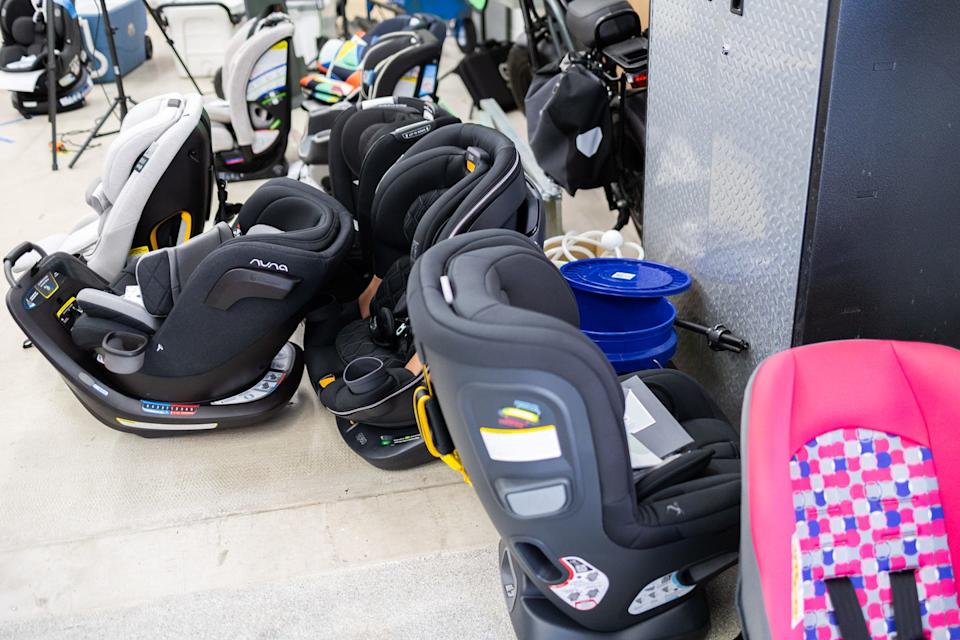
How Car Seat Safety Is Certified
Every car seat that hits the market in the United States is required to meet a federal safety standard. But how that actually happens might surprise you. The regulation in question is called FMVSS 213, short for Federal Motor Vehicle Safety Standard 213. It sets the rules for how child seats need to perform in crash tests: mostly front-facing collisions but now also side impacts thanks to a major update finalized in December 2024 (although compliance to these new rules isn't required until December 5, 2026, following a few extensions). Specifically, this recent update added tougher sled testing, stricter injury thresholds, and better requirements for head and chest protection.
But here's the part most people don't realize: Car-seat manufacturers aren't required to send their products to a government agency for testing. Companies are expected to handle testing themselves, either in their own crash labs or through an independent test facility. Once a seat passes, the company self-certifies that it meets the standards within FMVSS 213. That's it. As long as the manufacturers test and approve their car seats for the specified standards, they can start selling the seat to the public, no official government approval required.
The National Highway Traffic Safety Administration (NHTSA) does do some oversight. Specifically, it buys seats off store shelves and runs its own compliance tests as an audit to make sure manufacturers aren't skirting the standards. But the results of those tests aren't made public unless a seat fails badly enough to warrant a recall.
We spent hours poring over the details and discovered it's difficult to figure out how the entire testing and compliance process works behind the scenes, but the long and short of it is that the entire system largely relies on self-reporting and self-testing. So, while every seat you can buy legally is considered "safe," there's no official ranking or published list of which ones perform better in a crash.
That's why we believe the rest of the car-seat experience (how well the seat fits your car, how securely it installs, and how easily you can use it) is just as important as crash data. After all, if a seat doesn't install tightly or you're constantly fighting with the harness every time you strap in your child, it's more likely to be incorrectly installed or not keep your little one safe in the event of an accident.
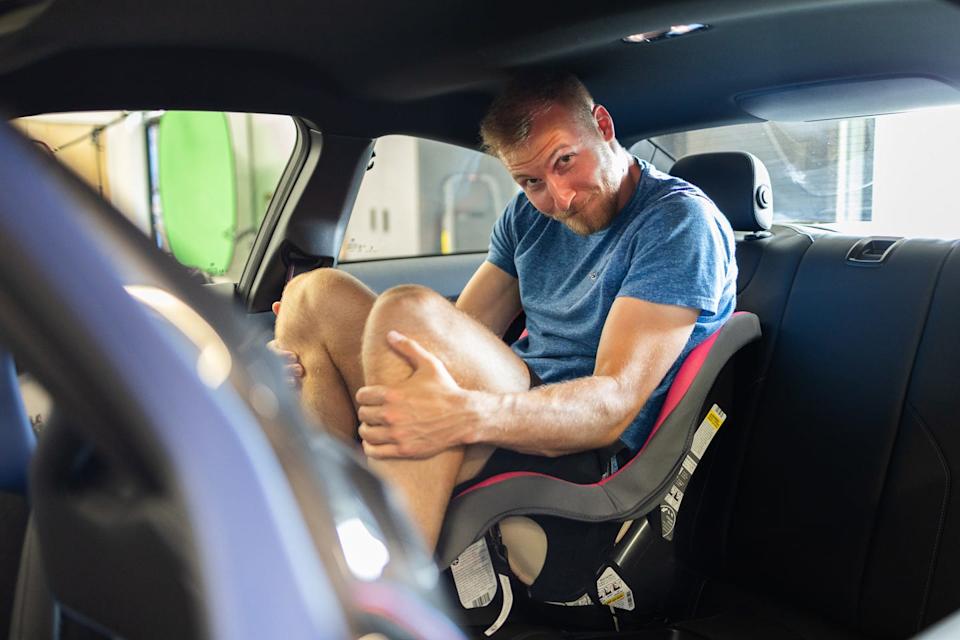
Why Trust Us
The Gear Team helps readers make informed purchasing choices about automotive gear, tools, and accessories through hands-on product evaluations and comprehensive testing. Autoweek's renowned testing standards mandate that we use all products we feature and that our findings and recommendations are based on personal experience and knowledge—not hype. We won't claim to have tested something we haven't, and we'll never recommend a product we wouldn't buy ourselves.
We've evaluated dozens of product categories, including pressure washers, cargo e-bikes, and cordless impact wrenches. The Gear Team's product selection and gear picks are editorially independent; Car and Driver has a strict policy against accepting payment for placement in articles. Read more about our testing process here.
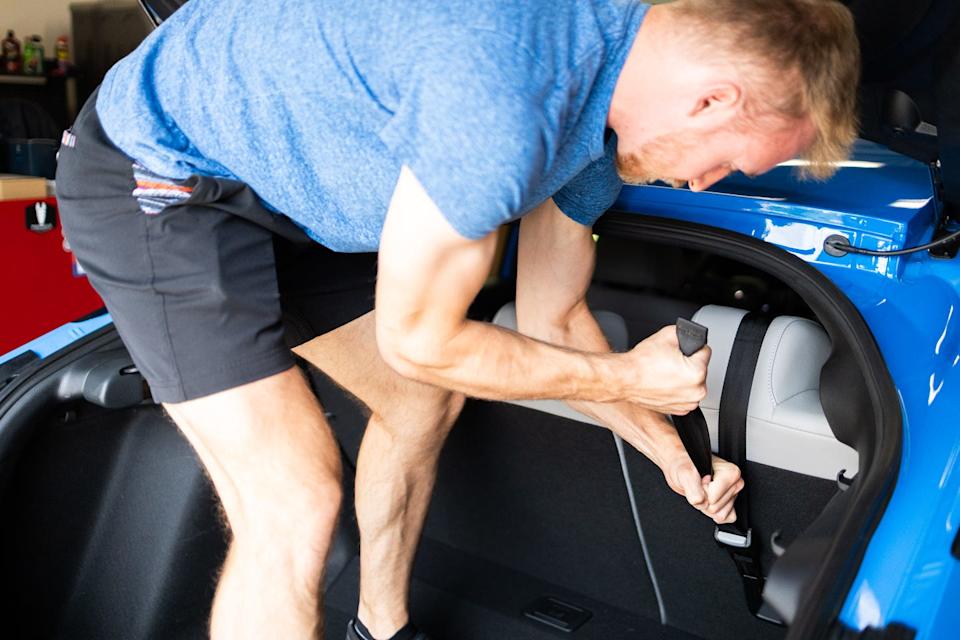
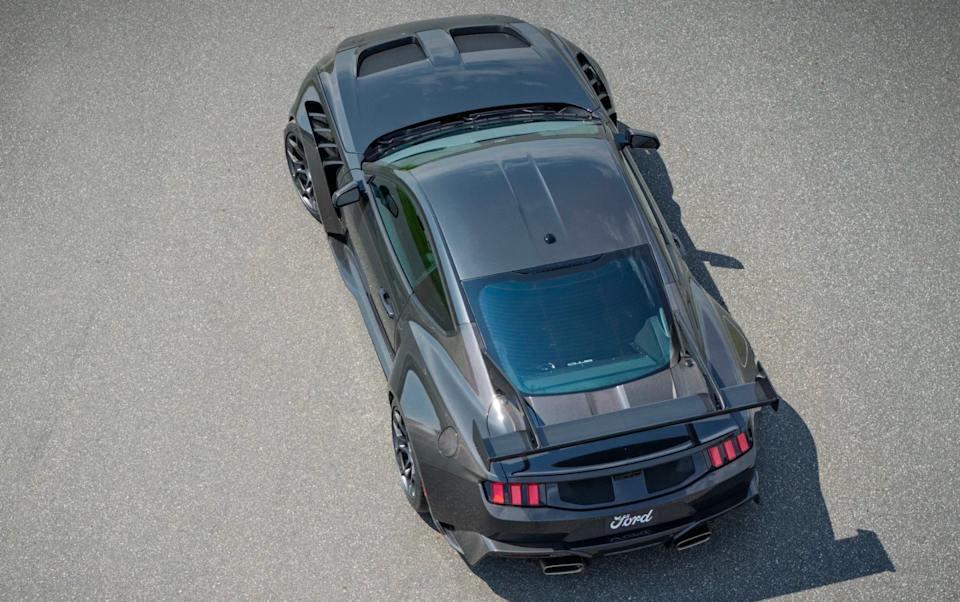
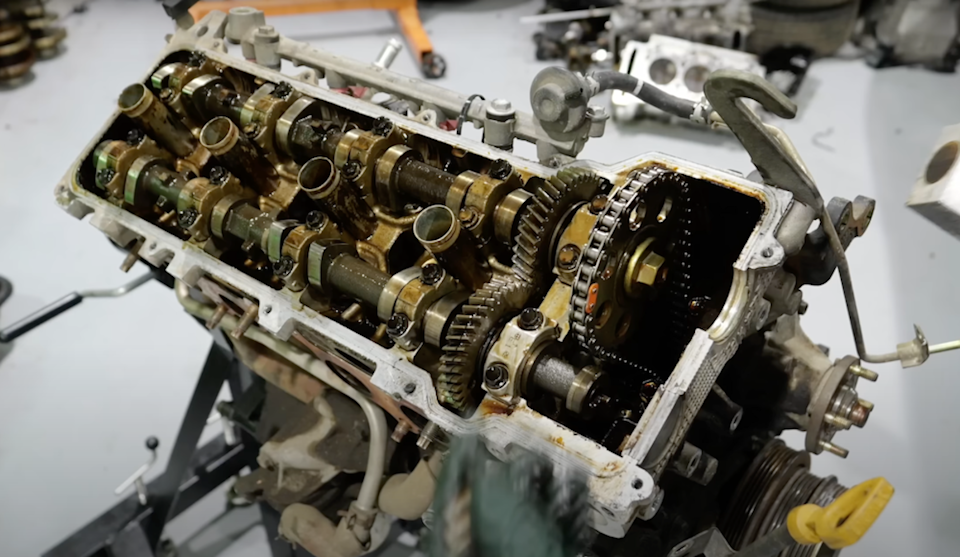
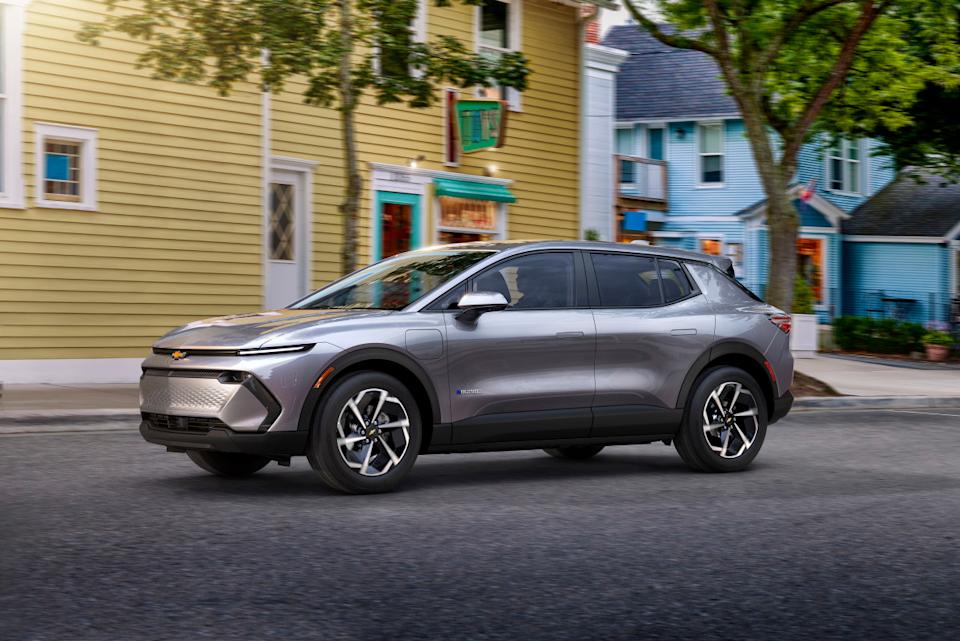
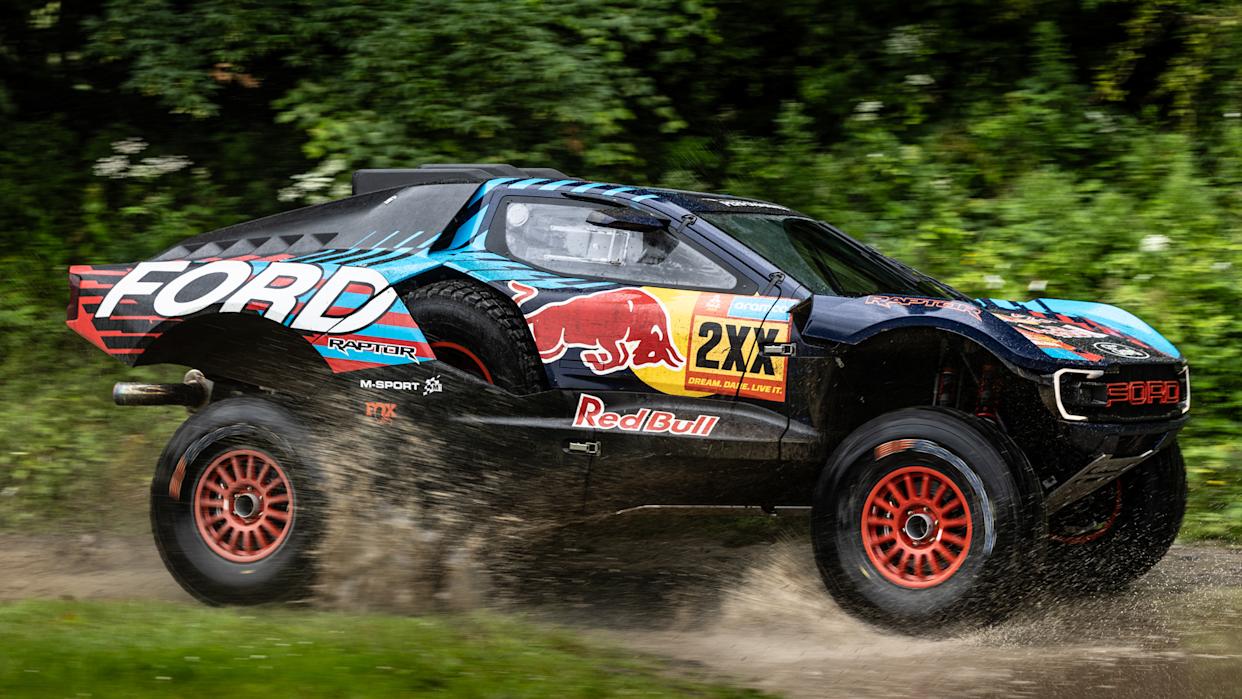

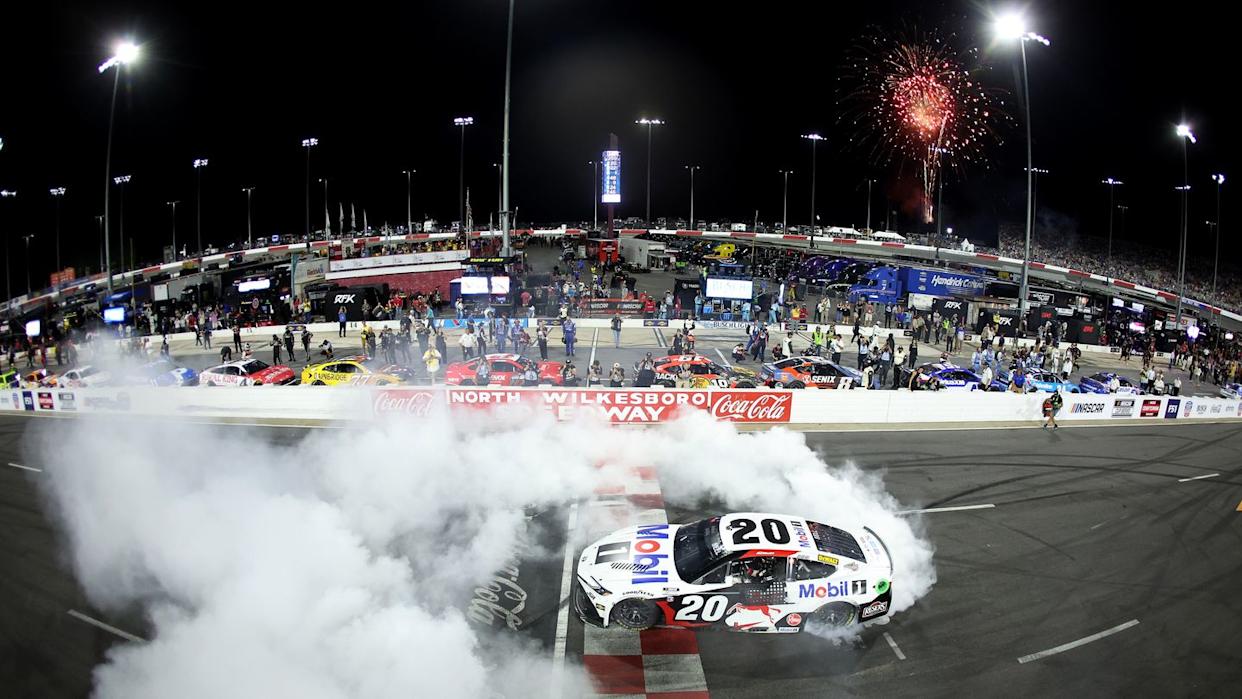

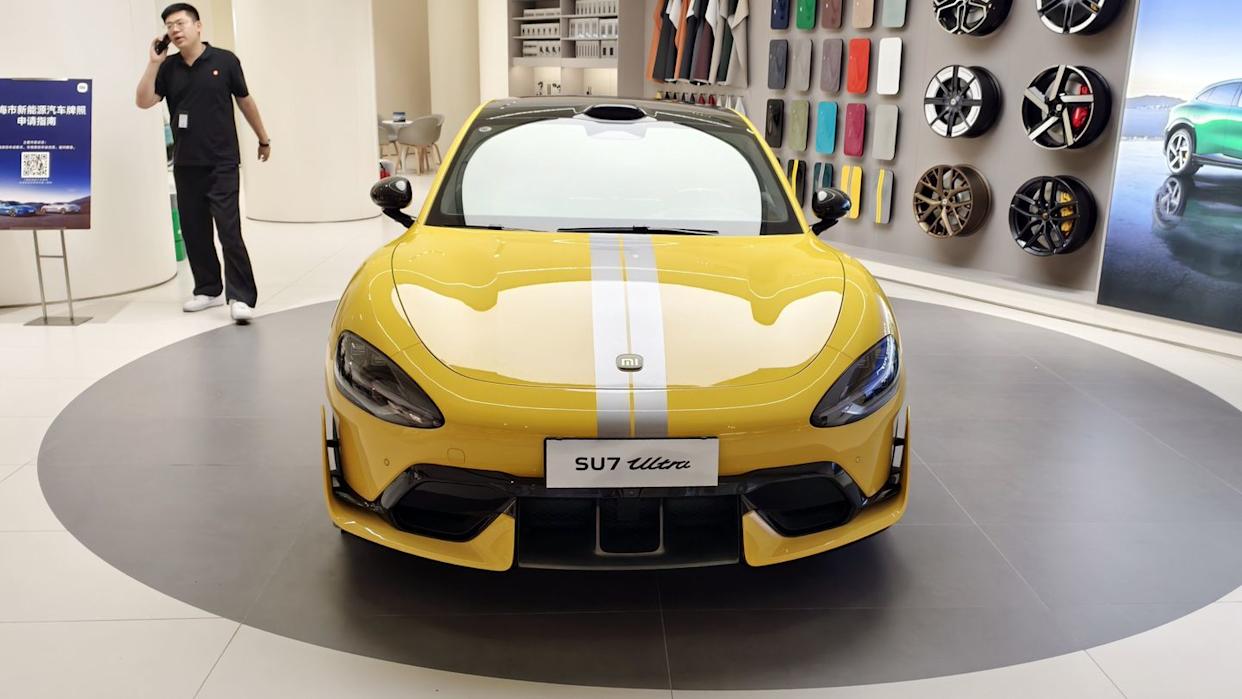
Comments